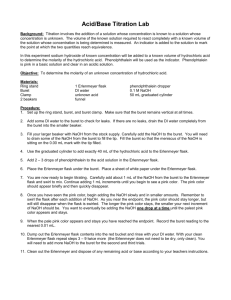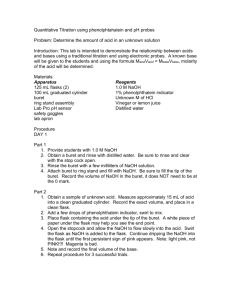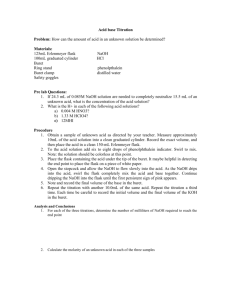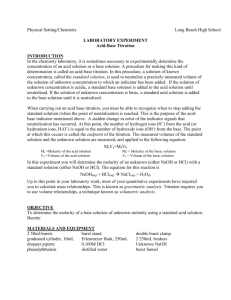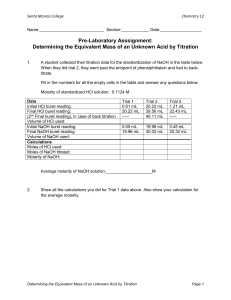Acid/Base Titration Lab
advertisement
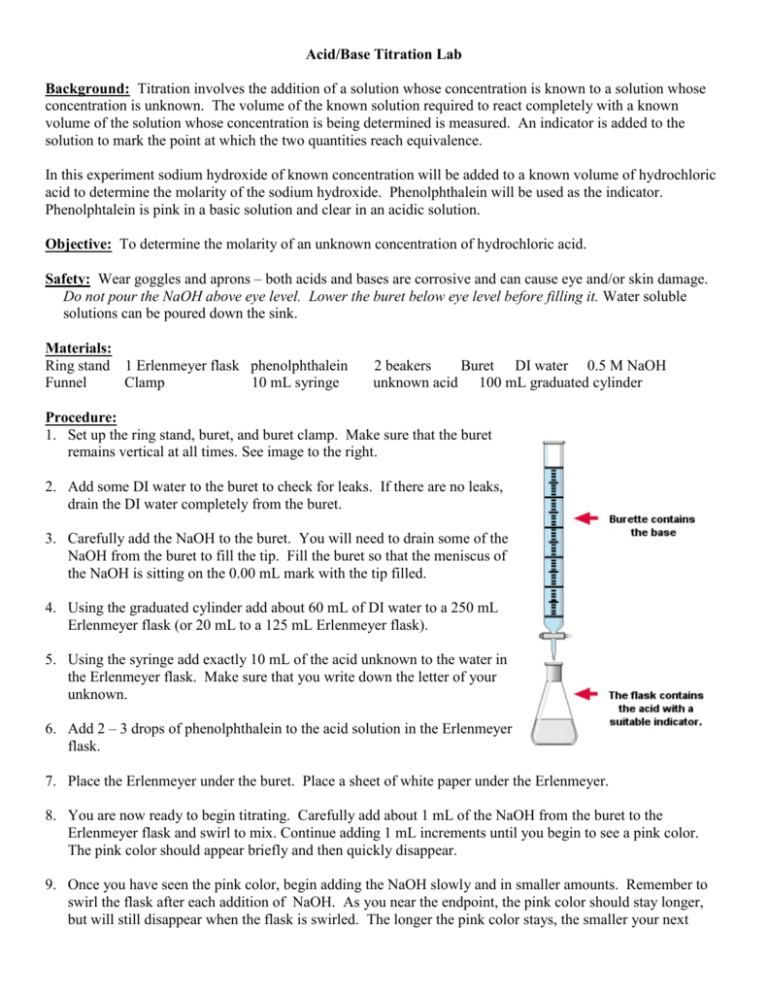
Acid/Base Titration Lab Background: Titration involves the addition of a solution whose concentration is known to a solution whose concentration is unknown. The volume of the known solution required to react completely with a known volume of the solution whose concentration is being determined is measured. An indicator is added to the solution to mark the point at which the two quantities reach equivalence. In this experiment sodium hydroxide of known concentration will be added to a known volume of hydrochloric acid to determine the molarity of the sodium hydroxide. Phenolphthalein will be used as the indicator. Phenolphtalein is pink in a basic solution and clear in an acidic solution. Objective: To determine the molarity of an unknown concentration of hydrochloric acid. Safety: Wear goggles and aprons – both acids and bases are corrosive and can cause eye and/or skin damage. Do not pour the NaOH above eye level. Lower the buret below eye level before filling it. Water soluble solutions can be poured down the sink. Materials: Ring stand 1 Erlenmeyer flask phenolphthalein Funnel Clamp 10 mL syringe 2 beakers Buret DI water 0.5 M NaOH unknown acid 100 mL graduated cylinder Procedure: 1. Set up the ring stand, buret, and buret clamp. Make sure that the buret remains vertical at all times. See image to the right. 2. Add some DI water to the buret to check for leaks. If there are no leaks, drain the DI water completely from the buret. 3. Carefully add the NaOH to the buret. You will need to drain some of the NaOH from the buret to fill the tip. Fill the buret so that the meniscus of the NaOH is sitting on the 0.00 mL mark with the tip filled. 4. Using the graduated cylinder add about 60 mL of DI water to a 250 mL Erlenmeyer flask (or 20 mL to a 125 mL Erlenmeyer flask). 5. Using the syringe add exactly 10 mL of the acid unknown to the water in the Erlenmeyer flask. Make sure that you write down the letter of your unknown. 6. Add 2 – 3 drops of phenolphthalein to the acid solution in the Erlenmeyer flask. 7. Place the Erlenmeyer under the buret. Place a sheet of white paper under the Erlenmeyer. 8. You are now ready to begin titrating. Carefully add about 1 mL of the NaOH from the buret to the Erlenmeyer flask and swirl to mix. Continue adding 1 mL increments until you begin to see a pink color. The pink color should appear briefly and then quickly disappear. 9. Once you have seen the pink color, begin adding the NaOH slowly and in smaller amounts. Remember to swirl the flask after each addition of NaOH. As you near the endpoint, the pink color should stay longer, but will still disappear when the flask is swirled. The longer the pink color stays, the smaller your next increment of NaOH should be. You want to eventually be adding the NaOH one drop at a time until the palest pink color appears and stays. 10. When the pale pink color appears and stays you have reached the endpoint. Record the buret reading to the nearest 0.01 mL. 11. Clean out the Erlenmeyer flask and repeat steps 4 – 10 twice more (the Erlenmeyer does not need to be dry, only clean). The solution in the Erlenmeyer can be poured down the drain. You will not need to add more NaOH to the buret for the second trial. Before you start the third trial, make sure that you have enough NaOH in the buret to complete the titration (use your values from the first and second trials to estimate the amount needed for the third trial). 12. Clean out the Erlenmeyer and dispose of any remaining acid or base according to your teachers instructions. Data Table: Unknown _____ Final Buret Reading (mL) Initial Buret Reading (mL) Volume of Base (mL) Molarity of Base (M) Volume of Acid (mL) Molarity of Acid (M) Average Molarity of Acid (M) Trial 1 Trial 2 Trial 3 Processing the Data: 1. Write a balanced equation for the reaction in this titration. 2. Calculate the molarity of the acid. Show all work. 3. Calculate the average molarity of the acid. Postlab questions: 1. We did not use the volume of the water added initially to the Erlenmeyer in our calculations. Why? 2. Describe the apparent relationship between [H3O+1] and [OH-1] when the endpoint is reached in an acid-base titiration. 3. If 30.0 mL of 0.500 M KOH are needed to neutralize 10.0 mL of HCl of unknown concentration, what is molarity of the HCl? 4. How many mL of 0.100 M NaOH are needed to titrate 20.0 mL of 0.300 M H2SO4? Lab Write Up: Introduction: Title, date, your name, partner names, brief explanation & hypothesis/research statement Materials & Methods: List of equipment and brief overview of steps Data: Tables to record your quantitative and qualitative observations Results: Any calculations & presentations of data (graphs, charts, etc.)—nonbiased explanation of data. This should include--unknown letter, average molarity, and standard deviation Summary: A conclusion. This “answers” your hypothesis or research question. You should explain how the data either fits or doesn’t fit in regards to your hypothesis/research statement. You should also address error analysis, potential modifications & future work


